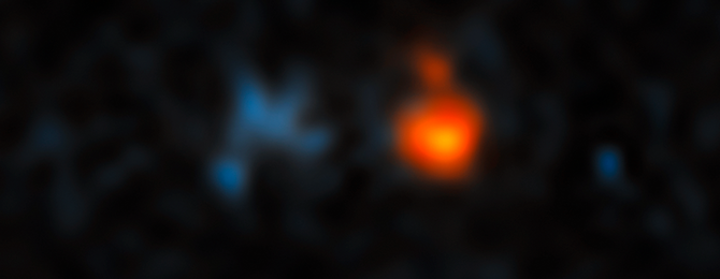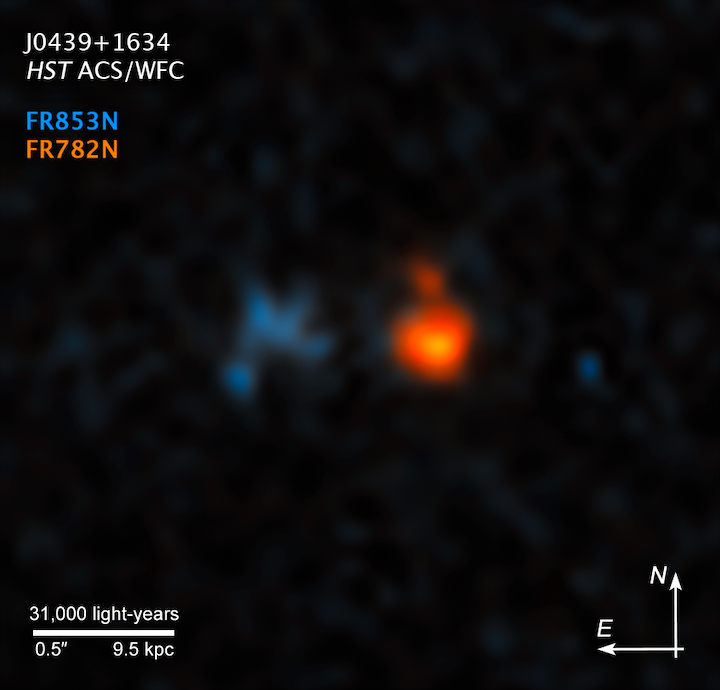11.01.2019

Zoom Lens in Space Gives Hubble a Peek into the Era of Galaxy Birth
Less than a billion years after the big bang, a monster black hole began devouring anything within its gravitational grasp. This triggered a firestorm of star formation around the black hole. A galaxy was being born. A blowtorch of energy, equivalent to the light from 600 trillion Suns, blazed across the universe. Now, 12.8 billion years later, the Hubble Space Telescope captured the beacon from this event. But Hubble astronomers needed help to spot it. The gravitational warping of space by a comparatively nearby intervening galaxy greatly amplified and distorted the quasar's light, making it the brightest such object seen in the early universe. It offers a rare opportunity to study a zoomed-in image of how supermassive black holes accompanied star formation in the very early universe and influenced the assembly of galaxies.
-

Astronomers have discovered the brightest object ever seen at a time when the universe was less than one billion years old, with the help of NASA's Hubble Space Telescope. The brilliant beacon is a quasar, the core of a galaxy with a black hole ravenously eating material surrounding it.
Though the quasar is very far away — 12.8 billion light-years — astronomers can detect it because a galaxy closer to Earth acts as a lens and makes the quasar look extra bright. The gravitational field of the closer galaxy warps space itself, bending and amplifying the distant quasar’s light. This effect is called gravitational lensing.
Though researchers have searched for these very remote quasars for over 20 years, a rare and fortuitous celestial alignment made this one visible to them. "We don't expect to find many quasars brighter than that in the whole observable universe," said lead investigator Xiaohui Fan of the University of Arizona, in Tucson.
The super-bright quasar, cataloged as J043947.08+163415.7, could hold the record of being the brightest in the early universe for some time, making it a unique object for follow-up studies.
Shining with light equivalent to 600 trillion Suns, the quasar is fueled by a supermassive black hole at the heart of a young galaxy in the process of forming. An immense amount of energy is emitted as the black hole consumes material around it. The detection provides a rare opportunity to study a zoomed-in image of how such black holes accompanied star formation in the very early universe and influenced the assembly of galaxies.
Besides being bright in visible and infrared wavelengths, the lensed quasar is also bright in submillimeter wavelengths, where it was observed with the James Clerk Maxwell Telescope on Mauna Kea, Hawaii. This is due to hot dust heated by intense star formation in the galaxy hosting the lensed quasar. The formation rate is estimated to be up to 10,000 stars per year (by comparison, our Milky Way galaxy makes one star per year).
"Clearly, this black hole is not only accreting gas, but has a lot of star formation around it," said team member Jinyi Yang at the University of Arizona. "However, because of the boosting effect of gravitational lensing, the actual rate of star formation could be much lower than the observed brightness suggests," she added.
The quasar existed at a transitional period in the universe's evolution, called reionization, where light from young galaxies and quasars reheated the obscuring hydrogen that cooled off not long after the big bang.
The quasar would have gone undetected if not for the power of gravitational lensing, which boosted its brightness by a factor of 50.
However, because very distant quasars are identified by their red color (due to absorption by diffuse gas in intergalactic space), sometimes their light is "contaminated," and looks bluer because of the starlight of an intervening galaxy. As a result, they may be overlooked in quasar searches because their color is diluted to resemble that of a normal galaxy. Fan proposes that many other remote quasars have been missed due to this light contamination.
His team got lucky with finding J043947.08+163415.7, because the quasar is so bright it drowns out the starlight from the especially faint foreground lensing galaxy. "Without this high level of magnification, it would make it impossible for us to see the galaxy," said team member Feige Wang of the University of California, Santa Barbara. "We can even look for gas around the black hole and what the black hole may be influencing in the galaxy."
The object was selected by its color by combining photometric data from the United Kingdom Infrared Telescope Hemisphere Survey, the Panoramic Survey Telescope and Rapid Response System (Pan-STARRS1) at optical wavelengths, and NASA's Wide-field Infrared Survey Explorer archive in the mid-infrared.
Follow-up spectroscopic observations were conducted by the University of Arizona's Multi-Mirror Telescope, the Gemini Observatory and the Keck Observatory. These observations revealed the signature of a very faint foreground galaxy directly between the quasar and Earth that is magnifying the quasar image. However, because the source looks fuzzy in the ground-based observations (and so could be mistaken for only a galaxy), the researchers used Hubble's exquisite imaging capabilities to confirm it is a lensed quasar.
"It's a hard system to photograph because it turns out to be so compact, which requires the sharpest view from Hubble," Fan said.
The quasar is ripe for future scrutiny. Fan's team is analyzing a detailed 20-hour spectrum from the European Southern Observatory's Very Large Telescope, which would show gas absorption features to identify chemical composition and temperatures of intergalactic gas in the early universe. Astronomers also will use the Atacama Large Millimeter/submillimeter Array, and eventually NASA's James Webb Space Telescope, to look within 150 light-years of the black hole to directly detect the influence of the black hole's gravity on gas motion and star formation in its vicinity.
Fan will present the team's results at a press conference Jan. 9, 2019, at the 233rd meeting of the American Astronomical Society in Seattle, Washington. The team's science paper is available online in The Astrophysical Journal Letters.
The Hubble Space Telescope is a project of international cooperation between NASA and ESA (European Space Agency). NASA's Goddard Space Flight Center in Greenbelt, Maryland, manages the telescope. The Space Telescope Science Institute (STScI) in Baltimore, Maryland, conducts Hubble science operations. STScI is operated for NASA by the Association of Universities for Research in Astronomy in Washington, D.C.
Quelle: NASA

